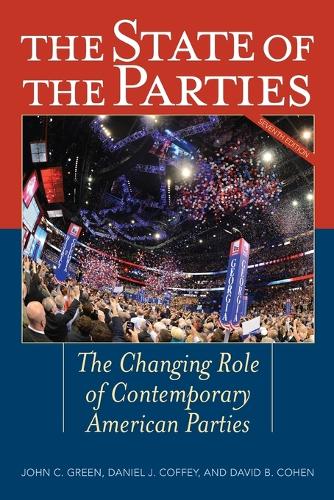
The State of the Parties: The Changing Role of Contemporary American Parties
(Paperback, Seventh Edition)
Available Formats
Hardback, Seventh Edition
Published: 21st August 2014
Paperback, Seventh Edition
Published: 21st August 2014
Publishing Details
The State of the Parties: The Changing Role of Contemporary American Parties
By (Author) John C. Green
Edited by Daniel J. Coffey
Edited by David B. Cohen
Contributions by Alan Abramowitz
Contributions by Paul A. Beck
Contributions by Michael John Burton
Contributions by Edward G. Carmines
Contributions by William F. Connelly
Contributions by Meredith Dost
Contributions by Diana Dwyre
Bloomsbury Publishing PLC
Rowman & Littlefield Publishers
21st August 2014
Seventh Edition
United States
Classifications
Tertiary Education
Non Fiction
Political structure and processes
324.273
Physical Properties
Paperback
410
Width 154mm, Height 227mm, Spine 29mm
617g
Description
Continuing a three-decade tradition, The State of the Parties 7th edition brings together leading experts to evaluate change and continuity in American electoral politics. Political parties in America have never been more contentious and divided than they are right now. Even splits within the parties themselves have the power to elevate relatively unknown candidates to power and topple established incumbents. With sections devoted to polarization and the electorate, polarization and political elites, tea party politics, super PACS, and partisan resources and partisan activities, the contributors survey the American political landscape. They pay special attention to polarization between and within the parties in the aftermath of the 2012 election, demographic changes to Americas political parties, the effects of new media and campaign finance laws on national and local electoral results, the Tea Partys rise and, as always, the implications of all these factors on future policymaking and electoral prospects. The State of the Parties 7th edition offers an indispensable guide to American politics for scholars, students, and practitioners. Contributions by: Alan Abramowitz, Paul A. Beck, Michael John Burton, Edward G. Carmines, Daniel J. Coffey, William F. Connelly, Jr., Meredith Dost, Diana Dwyre, Michael J. Ensley, Peter L. Francia, Erik Heidemann,,Shannon Jenkins, Caitlin E. Jewitt, David C. Kimball, Robin Kolodny, Thad Kousser, David B. Magleby, Seth Masket, William G. Mayer, Eric McGhee, William J. Miller, Jonathan S. Morris, Ronald Rapoport, Douglas D. Roscoe, Dante Scala, Daniel M. Shea, Boris Shor, Walter Stone, Jeffrey M. Stonecash, Eric C. Vorst, Michael W. Wagner
Reviews
I always look forward to the new edition of The State of the Parties! It offers those of us who study and teach about party politics the most up-to-date research from a wide range of perspectives and by distinguished parties scholars. -- Marjorie R. Hershey, Indiana University
Polarization in US politics is typically characterized as red versus blue states, yet political parties in the US have never been more divided and contentious. The aftermath of the 2012 presidential election speaks to the chasm that separates the two parties. The State of the Parties, edited by Green, Coffey, and Cohen, highlights that those divisions are only part of the dynamic shaping the American political landscape. Identifying both party change and continuity, this editions prominent and emerging scholars examine the 'state of parties,' polarization of the electorate, polarization of the political elites, Tea Party politics, Super PACs and partisan resources, and partisan activities. The contributors' well-documented analyses persuasively illustrate that polarization between the parties is rooted deep within the electorate, polarization is intense among the party elites, the Republican Party has serious internal divisions, and the Tea Party will remain a force within the GOP. The research confirms that American political parties, central to all aspects of politics in a functioning democracy, are vibrant and dynamic institutions. Summing Up: Recommended. Upper-division undergraduate, graduate, research, and professional collections. * CHOICE *
Author Bio
John C. Green is Distinguished Professor of Political Science and director of the Ray C. Bliss Institute of Applied Politics at The University of Akron. Daniel J. Coffey is assistant professor of political science at The University of Akron and a fellow in the Ray C. Bliss Institute of Applied Politics. He has published in State Politics and Policy Quarterly. He studies political parties, public opinion, state and local politics, campaigns and elections, and research methods. David B. Cohen is professor of political science and fellow in the Ray C. Bliss Institute of Applied Politics at The University of Akron.
